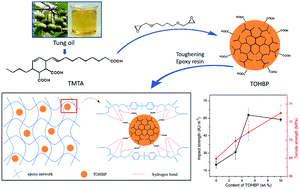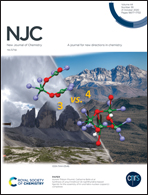A hyperbranched polymer from tung oil for the modification of epoxy thermoset with simultaneous improvement in toughness and strength†
Abstract
In order to increase the toughness of epoxy resin and make full use of biological resources, a tung oil-based hyperbranched polymer (TOHBP) was synthesized. The structure of the TOHBP was determined by FTIR, NMR and gel permeation chromatography (GPC). After TOHBP was incorporated into an epoxy/polyetherdiamine curing system, different analytical studies were carried out to characterize samples of each formation. The results show simultaneous improvement in the impact strength (62.79 kJ m−2), tensile strength (73.01 MPa), modulus (3116 MPa) and glass transition temperature (Tg) (86.62 °C) compared with neat epoxy resin (20.07 kJ m−2, 67.97 MPa, 2610 MPa and 81.48 °C, respectively). In addition, the significant improvement in impact strength and the simultaneous reinforcement of other properties suggest that TOHBP provides a better toughening and strengthening ability than many other reported oil-based hyperbranched polymers (HBPs) and petroleum-based polymers. The results indicate that this renewable material is a promising modifier, and may provide an alternative to replace petroleum-based materials that increase the toughness of epoxy resins.



 Please wait while we load your content...
Please wait while we load your content...